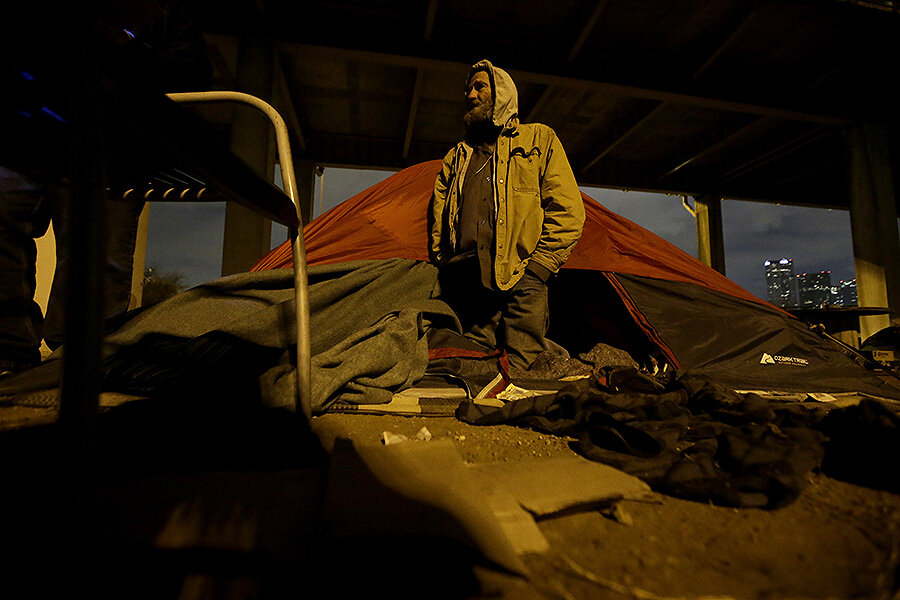How do you count the homeless in America?
Loading...
New York Mayor Bill De Blasio joined volunteers canvassing Big Apple streets early Tuesday morning, as they participated in the city's federally mandated, annual, point-in-time count of homelessness, scouring sidewalks, parks, and underpasses for New Yorkers without shelter.
"It's very, very sad to see, especially in the middle of a city with so much wealth," Mr. de Blasio told the Associated Press. "This is not the way it should be."
Advocates for the homeless need reliable data each year to pinpoint how many people will need services, and whether last year's efforts are actually working. But tracking down a large and moving population is a complicated process that requires short- and long-term tallies, and both local and nationwide data, to provide a meaningful picture.
"A point in time count is like a snapshot. It's not the movie. It gives you one view, but it doesn’t give you more in-depth stories," Nan Roman, president and chief executive officer of the National Alliance to End Homelessness, tells The Christian Science Monitor in a phone interview.
Day to day, city residents and even program staff often make assumptions based on anecdotal observations: Are more people congregating by this subway station? Are fewer people looking for lunch at the shelter? That localized data is important, and shelter workers often have the inside story federal reports can't tell.
But it's just one piece of the puzzle. To fight homelessness on a national level, and strategically design programs like Obama's $11 billion request for homeless families, the Department of Housing and Urban Development (HUD) mandates that cities receiving funding report homelessness data in two parts: an annual point-in-time census, conducted on a single night in January, and an aggregated annual report of services offered, to help compile a more holistic picture.
The point-in-time counts combine a tally of shelter beds with the number of people unsheltered on the streets that night, providing a crucial complement to year-long program tallies, which only show the number of people actively seeking help.
Some 1.49 million people used shelter programs in 2014, and 578,424 people were recorded in that year's point-in-time survey. About 40 percent of homeless individuals and 10 percent of homeless families surveyed during the point-in-time were unsheltered, sleeping on the streets, in tents, in cars, and other out of the way places.
But the one-night counts have plenty of critics, who point out that an accurate tally is nearly impossible. Particularly in January, when the cold is at its peak, people without shelter are likely to sleep in out-of-the-way locations volunteers can't find.
In Texas, Metro Dallas Homeless Alliance's CEO Cindy Crain tells volunteers to think, "It's cold tonight; where would you go?" Still, many slip through the cracks.
"It's a flawed measure and using it to make a comparison from one year to the next is deeply problematic since so many variables change," Giselle Routhier, the policy director of the Coalition for the Homeless in New York, told the Associated Press. "Doing it one day a year doesn't provide accuracy. And if you don't have an accurate read of the problem, you can't accurately identify solutions."
Point-in-time counts also miss the percentage of homeless people who aren't staying outdoors or in a shelter: those who have found housing for just a few days at a time with friends or family, for example.
Local programs' yearlong data is especially useful for figuring out the larger picture behind each person's homelessness, helping officials figure out which subpopulations need the most help, and what is or isn't working: who really is or isn't a veteran, or chronically homeless, for example.
Vets have often been well-served by "housing first" approaches, Ms. Roman says, a policy change now embraced by the White House and some cities launching new initiatives against homelessness, from Utah to Hawaii.
The logic is simple: once basic needs like food and housing are met, people are better prepared to tackle bigger challenges like employment, or addiction. Housing should be the first step, not a reward.
"There used to be much more of a philosophy of you should 'get your act together' and then you’ll get housing. And now I think we’re realizing it’s really difficult to 'get your act together' if you don’t have a place to live," she says. "It’s better for them, and it’s often better for the taxpayer, if people get housed."
This report includes material from the Associated Press.






